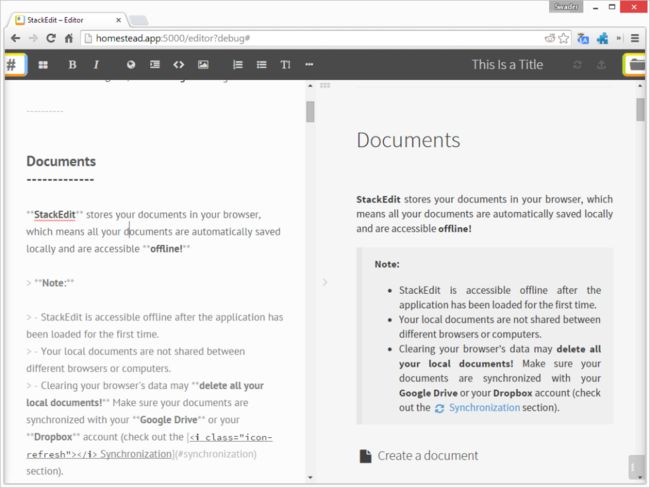stackedit_在StackEdit中实现TitleCapitalization
stackedit
在SitePoint上为PHP Channel撰写帖子时,我经常忘记如何正确使用标题。 我通常最终会使用TitleCapitalization进行快速修复,但是我常常幻想在StackEdit的title字段旁边有一个按钮来快速自动应用。 好了,我们已经介绍了启动和运行本地(或多个)StackEdit的问题。 为什么也不要构建按钮?
准备好
为了准备升级,我们需要签出StackEdit的本地副本。 我当然会使用我可信赖的旧版宅基地改良盒,就像这里一样。 您可以使用自己的Linux操作系统,具体取决于您,但这绝对是最简单的。
git clone https://github.com/swader/homestead-improved hi_stackedit
cd hi_stackedit
vagrant up
vagrant ssh进入虚拟机后,我们将克隆StackEdit。
cd ~/Code
git clone https://github.com/benweet/stackedit
cd stackedit
npm install --no-bin-link 请注意,如果在运行此命令时遇到“无法解决”错误,并且以典型的节点“冗长”的方式出现了许多其他错误,则仅意味着某些依赖项丢失了。 进入package.json并从第23 行和第28 行删除主题标签值(如果它们仍然存在)。 这些标记引用的版本不再存在,并且在撰写本文时,StackEdit的作者仍未更新StackEdit的文件以反映这一点。
bower install这需要一段时间。 如果安装了BowerPHP ,则可以使用它。
要运行本地副本,请执行以下操作:
(export PORT=5000 && node server.js) 然后,在浏览器中访问homestead.app:5000 (或您设置的任何主机,如果不是默认的homestead.app )。
实作
好吧,让我们开始吧。 该实现将由两部分组成-UI和逻辑。
用户界面
让我们添加按钮。
StackEdit在UI方面有些复杂,难以扩展。 安装后,项目本身包含超过30000个文件,其中包含下载的依赖项和批次。 这对于Web应用程序来说是荒谬的,并且对于任何IDE都很难索引,尤其是因为JavaScript有点混乱。 向界面添加按钮需要几个步骤。 我们要寻找的外观是这样的:
文档标题旁边的“复选标记”图标,形式为Glyphicon ,根据使用的主题与其他UI匹配。 我使用复选标记是因为Glyphicons已包含在StackEdit的Bootstrap中。 在上下文上可能并不完美,但这是在不编辑太多文件的情况下获得所需内容的最快方法(默认情况下,我们将编辑很多文件,而增加这些开销毫无意义)。
我们需要编辑的视图是public/res/html/bodyEditor.html –我们将在第44行周围添加一个新的图标容器:
我们在“工作指示器”容器之后添加了一个“大写按钮”容器,因此我们的按钮出现在标题旁边,与标题的上下文最匹配。 不过,这只是容器。
StackEdit UI中的所有按钮都是使用JS构建的。 这发生在文件public/res/libs/Markdown.Editor.js 。 首先,让我们添加按钮标签。 该文件的顶部是defaultStrings数组。 编辑它以包含我们的标题大写标签,如下所示:
[...]
help: "Markdown Editing Help",
titlecapitalization: "Autocapitalize Title"
}; 然后,向下滚动到同一文件中的makeSpritedButtonRow函数,并在if (helpOptions) {块上方添加以下内容:
buttons.titlecapitalization = makeButton("wmd-titlecapitalization", getString("titlecapitalization"), "-240px", bindCommand(function (chunk, postProcessing) {
alert("Hello");
})); 这将创建一个与其余编辑器主题匹配的按钮,并为它提供一个title属性以及我们定义的字符串,因此当我们将鼠标悬停在该按钮上时可以看到它。 单击时还将显示“ Hello”。 但是,它仍然不会显示在界面中。 为此,我们需要编辑public/res/core.js
找到注释// Add customized buttons在该文件中// Add customized buttons ,然后转到该块的末尾。 在此添加以下内容:
$("#wmd-titlecapitalization").append($('')).prependTo($('.capitalize-button'));免费学习PHP!
全面介绍PHP和MySQL,从而实现服务器端编程的飞跃。
原价$ 11.95 您的完全免费
这将找到我们的按钮容器,并将我们新创建的按钮插入其中。 如果现在以调试模式( homestead.app:5000/editor?debug )刷新编辑器并单击按钮,则应该看到“ Hello”警报,如Markdown.Editor.js的回调所定义。
逻辑
现在已经添加了按钮,让我们按我们想要的去做。
首先,让我们获取标题字段的文本。 编辑Markdown.Editor.js 。 替换alert("Hello"); 在按钮的回调中包含以下内容:
console.log($(".title-container a").text());现在单击按钮将在控制台中生成当前文档标题。 到目前为止,一切都很好。
为了获得我们想要做什么的逻辑,我们将“借用” TitleCapitalization.com中的代码。 如果您查看源代码,您会发现它位于底部的脚本标记中。 稍微清理一下以删除特定于站点的内容,最终得到以下结果:
(function(){
var prepositions = [
'a',
'abaft',
'aboard',
'about',
'above',
'absent',
'across',
'afore',
'after',
'against',
'along',
'alongside',
'amid',
'amidst',
'among',
'amongst',
'an',
'apropos',
'apud',
'around',
'as',
'aside',
'astride',
'at',
'athwart',
'atop',
'barring',
'before',
'behind',
'below',
'beneath',
'beside',
'besides',
'between',
'beyond',
'but',
'by',
'circa',
'concerning',
'despite',
'down',
'during',
'except',
'excluding',
'failing',
'following',
'for',
'from',
'given',
'in',
'including',
'inside',
'into',
'lest',
'like',
'mid',
'midst',
'minus',
'modulo',
'near',
'next',
'notwithstanding',
'of',
'off',
'on',
'onto',
'opposite',
'out',
'outside',
'over',
'pace',
'past',
'per',
'plus',
'pro',
'qua',
'regarding',
'round',
'sans',
// while it technically can be a preoposition,
// (http://www.merriam-webster.com/thesaurus/save[preposition])
// it is usually used as a verb
// 'save',
'since',
'than',
'through',
'thru',
'throughout',
'thruout',
'till',
'times',
'to',
'toward',
'towards',
'under',
'underneath',
'unlike',
'until',
'unto',
'up',
'upon',
'versus',
'vs\.',
'vs',
'v\.',
'v',
'via',
'vice',
'with',
'within',
'without',
'worth'
];
var articles = [
'a',
'an',
'the'
];
var conjunctions = [
'and',
'but',
'for',
'so',
'nor',
'or',
'yet'
];
// var small = "(a|an|and|as|at|but|by|en|for|if|in|of|on|or|the|to|v[.]?|via|vs[.]?)";
var punct = "([!\"#$%&'()*+,./:;<=>?@[\\\\\\]^_`{|}~-]*)";
var all_lower_case = '(' + (prepositions.concat(articles).concat(conjunctions)).join('|') + ')';
console.log('all lower case', all_lower_case);
window.titleCaps = function(title){
var parts = [], split = /[:.;?!] |(?: |^)["Ò]/g, index = 0;
title = title.replace(/[\u2018\u2019]/g, "'")
.replace(/[\u201C\u201D]/g, '"');
while (true) {
var m = split.exec(title);
parts.push( title.substring(index, m ? m.index : title.length)
.replace(/\b([A-Za-z][a-z.'Õ]*)\b/g, function(all){
return /[A-Za-z]\.[A-Za-z]/.test(all) ? all : upper(all);
})
//.replace(RegExp("\\b" + small + "\\b", "ig"), lower)
//.replace(RegExp("^" + punct + small + "\\b", "ig"), function(all, punct, word){
// return punct + upper(word);
//})
//.replace(RegExp("\\b" + small + punct + "$", "ig"), upper));
.replace(RegExp("\\b" + all_lower_case + "\\b", "ig"), lower)
.replace(RegExp("^" + punct + all_lower_case + "\\b", "ig"), function(all, punct, word){
return punct + upper(word);
})
.replace(RegExp("\\b" + all_lower_case + punct + "$", "ig"), upper));
index = split.lastIndex;
if ( m ) parts.push( m[0] );
else break;
}
return parts.join("").replace(/ V(s?)\. /ig, " v$1. ")
.replace(/(['Õ])S\b/ig, "$1s")
.replace(/\b(AT&T|Q&A)\b/ig, function(all){
return all.toUpperCase();
});
};
function lower(word){
return word.toLowerCase();
}
function upper(word){
return word.substr(0,1).toUpperCase() + word.substr(1);
}
})();如果现在将其粘贴到控制台中,则可以访问名为“ titleCaps”的根函数,该根函数接受字符串并打印出标题大写的字符串。 这正是我们所需要的。
再次编辑按钮的回调,并将其更改为:
var titleContainer = $('.title-container a');
var capitalized = capitalize($(titleContainer).text());
$(titleContainer).text(capitalized);
$(".input-file-title").val(capitalized); 现在我们所缺少的只是capitalize功能。 环顾Markdown.Editor.js的代码,我们可以看到泛型函数仍然存在(例如,请参见properlyEncoded的Encoded)。 因此,我们也不需要再考虑将这样的想法纳入考虑范围。 在文件末尾,最后一个})();之前})(); ,添加以下内容:
var prepositions = [
'a',
'abaft',
'aboard',
'about',
'above',
'absent',
'across',
'afore',
'after',
'against',
'along',
'alongside',
'amid',
'amidst',
'among',
'amongst',
'an',
'apropos',
'apud',
'around',
'as',
'aside',
'astride',
'at',
'athwart',
'atop',
'barring',
'before',
'behind',
'below',
'beneath',
'beside',
'besides',
'between',
'beyond',
'but',
'by',
'circa',
'concerning',
'despite',
'down',
'during',
'except',
'excluding',
'failing',
'following',
'for',
'from',
'given',
'in',
'including',
'inside',
'into',
'lest',
'like',
'mid',
'midst',
'minus',
'modulo',
'near',
'next',
'notwithstanding',
'of',
'off',
'on',
'onto',
'opposite',
'out',
'outside',
'over',
'pace',
'past',
'per',
'plus',
'pro',
'qua',
'regarding',
'round',
'sans',
'since',
'than',
'through',
'thru',
'throughout',
'thruout',
'till',
'times',
'to',
'toward',
'towards',
'under',
'underneath',
'unlike',
'until',
'unto',
'up',
'upon',
'versus',
'vs\.',
'vs',
'v\.',
'v',
'via',
'vice',
'with',
'within',
'without',
'worth'
];
var articles = [
'a',
'an',
'the'
];
var conjunctions = [
'and',
'but',
'for',
'so',
'nor',
'or',
'yet'
];
var punct = "([!\"#$%&'()*+,./:;<=>?@[\\\\\\]^_`{|}~-]*)";
var all_lower_case = '(' + (prepositions.concat(articles).concat(conjunctions)).join('|') + ')';
console.log('all lower case', all_lower_case);
var capitalize = function(title){
var parts = [], split = /[:.;?!] |(?: |^)["Ò]/g, index = 0;
title = title.replace(/[\u2018\u2019]/g, "'")
.replace(/[\u201C\u201D]/g, '"');
while (true) {
var m = split.exec(title);
parts.push( title.substring(index, m ? m.index : title.length)
.replace(/\b([A-Za-z][a-z.'Õ]*)\b/g, function(all){
return /[A-Za-z]\.[A-Za-z]/.test(all) ? all : upper(all);
})
.replace(RegExp("\\b" + all_lower_case + "\\b", "ig"), lower)
.replace(RegExp("^" + punct + all_lower_case + "\\b", "ig"), function(all, punct, word){
return punct + upper(word);
})
.replace(RegExp("\\b" + all_lower_case + punct + "$", "ig"), upper));
index = split.lastIndex;
if ( m ) parts.push( m[0] );
else break;
}
return parts.join("").replace(/ V(s?)\. /ig, " v$1. ")
.replace(/(['Õ])S\b/ig, "$1s")
.replace(/\b(AT&T|Q&A)\b/ig, function(all){
return all.toUpperCase();
});
};
function lower(word){
return word.toLowerCase();
}
function upper(word){
return word.substr(0,1).toUpperCase() + word.substr(1);
}如果您现在对此进行测试,您会发现“ Hello world”之类的标题被大写为“ Hello World”。 单击标题字段,您会注意到它也适用于内部文本–一切均已正确大写:
结论
在本文中,我们首先在本地托管了MarkDown编辑器StackEdit,从而实现了所需的新功能。 我们添加了一个按钮,从TitleCapitalization窃取了功能,并将其回收到我们的环境中。 如果愿意,我们现在可以使用此升级将拉取请求发送给项目所有者。 在您阅读本文时,它可能会被接受,也可能会被拒绝,但是无论如何,我们的本地副本已实现了功能,我们可以按预期使用它。
注释? 反馈? 让我知道!
翻译自: https://www.sitepoint.com/implementing-titlecapitalization-stackedit/
stackedit

